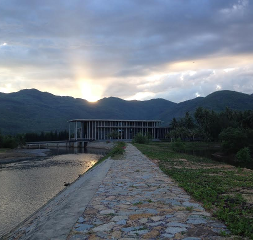Speaker
Description
COHERENT
Coherent, elastic neutrino-nucleus scattering (CEvNS) was first predicted in 1974 as an essential process in the standard model of electroweak interactions. Forty-two years later it is still undetected. Taking advantage of technologies that have recently come to maturity, and the availability of a world-class pulsed neutrino source, the COHERENT collaboration seeks to make the first unambiguous measurement of this process. The Oak Ridge National Laboratory Spallation Neutron Source (SNS) is, as a by-product of the spallation process, the world’s most intense pulsed neutrino source. Neutrinos at the SNS are produced as result of decay at rest pions and muons, and therefore the energy spectrum of emitted neutrinos is well suited for CEvNS detection: En < 53 MeV. The pulsed nature and short duty cycle of the SNS beam allow for powerful reductions of backgrounds not associated with the beam. The COHERENT Collaboration is deploying a suite of low threshold detectors (CsI scintillator, high-purity Ge detector array, LAr and NaI scintillator) at the SNS to detect CEvNS, in a manner that limits systematic uncertainties and observes the predicted N-squared-dependence on the cross section. The current status of the collaboration¹s efforts will be discussed and longer-term physics goals of the collaboration will be addressed, including searches for non-standard neutrino interactions and a measurement of the weak mixing angle. Assessments of the backgrounds present in the detector locations will be discussed as well.
Summary
COHERENT
Coherent, elastic neutrino-nucleus scattering (CEvNS) was first predicted in 1974 as an essential process in the standard model of electroweak interactions. Forty-two years later it is still undetected. Taking advantage of technologies that have recently come to maturity, and the availability of a world-class pulsed neutrino source, the COHERENT collaboration seeks to make the first unambiguous measurement of this process. The Oak Ridge National Laboratory Spallation Neutron Source (SNS) is, as a by-product of the spallation process, the world’s most intense pulsed neutrino source. Neutrinos at the SNS are produced as result of decay at rest pions and muons, and therefore the energy spectrum of emitted neutrinos is well suited for CEvNS detection: En < 53 MeV. The pulsed nature and short duty cycle of the SNS beam allow for powerful reductions of backgrounds not associated with the beam. The COHERENT Collaboration is deploying a suite of low threshold detectors (CsI scintillator, high-purity Ge detector array, LAr and NaI scintillator) at the SNS to detect CEvNS, in a manner that limits systematic uncertainties and observes the predicted N-squared-dependence on the cross section. The current status of the collaboration¹s efforts will be discussed and longer-term physics goals of the collaboration will be addressed, including searches for non-standard neutrino interactions and a measurement of the weak mixing angle. Assessments of the backgrounds present in the detector locations will be discussed as well.
